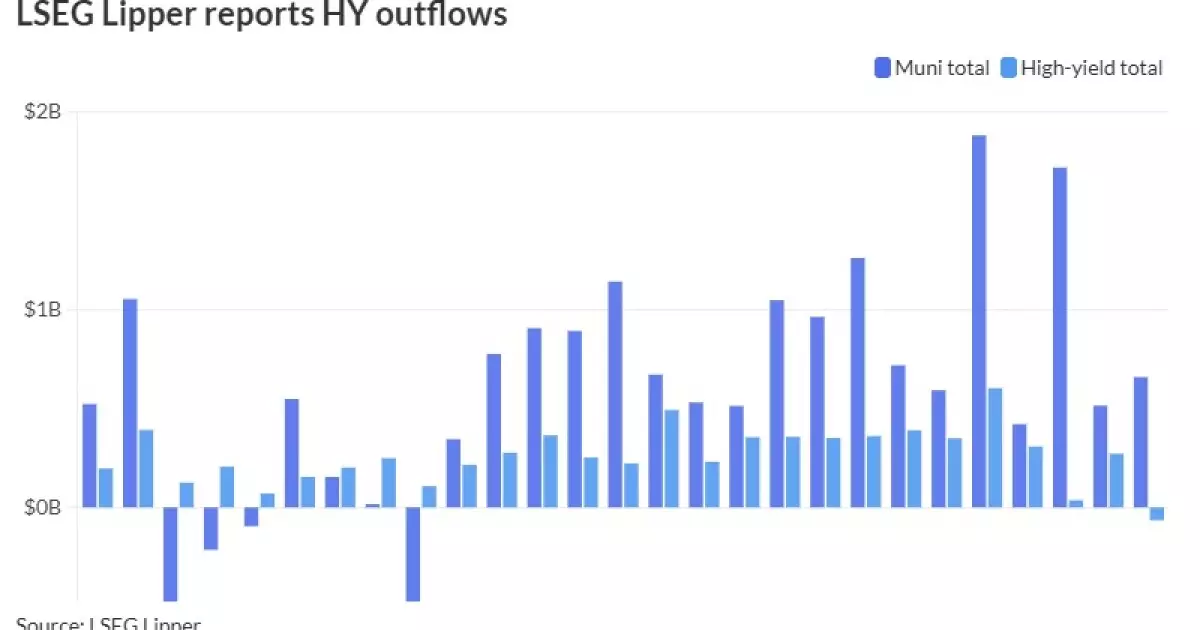As October concludes, the municipal bond market finds itself at an inflection point. Despite experiencing slight changes in the last trading session of the month, it is an essential period filled with significant implications for investors. A nuanced look reveals a juxtaposition between relative stability in municipal bonds and notable shifts in mutual fund inflows, particularly with high-yield funds experiencing outflows for the first time in six months. This contradicts the prevailing trend where municipal investments generally attract capital during market downturns, highlighting potential risks and adjustments within the sector.
In the backdrop of this volatility, U.S. Treasuries tell a different story. Their performance has been mixed, reflecting a broader uncertainty in the equities market, which has suffered losses recently. Kim Olsan, a senior fixed-income portfolio manager at NewSquare Capital, summarizes this market dynamic effectively by stating that recent corrections have led to yields that may be more appealing to buyers seeking to capitalize on attractive rates.
The month of October has witnessed a substantial correction, notably reflected in the Bloomberg Municipal Index, which reported a decline of 1.51% as of the last trading session. This downturn is marked as one of the most significant since October 2009, raising alarm bells among investors and stakeholders. Comparatively, U.S. Treasuries’ losses of 2.42%, and U.S. corporate debt’s estimated 2.29% decline suggest that the municipal market’s vulnerability has its counterparts, though the municipal bonds are comparatively less afflicted.
One crucial takeaway from this performance narrative is the relationship between yields and investment behavior. Olsan implies that the widening spreads and greater yields could encourage more investor interest. For example, the two-year municipal bond to UST ratio stands at 65%, indicating a potentially attractive entry point for investments in shorter maturities. The momentum is shifting toward a defensive posture as yields begin to align more favorably against risk-weighted alternatives. This presents a valuable opportunity for both seasoned and new investors to engage in defensive strategies while assessing the overall value of bonds.
Investment Opportunities in the Primary Market
The primary market scenario illustrates diverse investment opportunities. Recently, BofA Securities priced approximately $189 million in sustainability lease revenue bonds closely tied to the Washington state DSHS Project. The yield profile for bonds with varying maturities—ranging from 2.97% to 4.30%—demonstrates an attractive offering that highlights the varied yield landscape available in the current market. Municipal bonds from entities like the Charleston County School District further showcase this dynamic, revealing diverse yields and potential for investment.
However, as we look ahead, the forecast indicates a dramatic decline in supply after high issuance levels, noted at over $56 billion in October—reflective of robust activity during the month. Looking forward, with only $3.77 billion visible supply anticipated in the coming weeks, the landscape will demand a more strategic approach from investors. The correlation between impending economic events—such as the upcoming elections—and bond performance is particularly critical, indicating that investor sentiment could fluctuate significantly based on external influences.
Trends in Mutual Fund Flows
Mutual fund flows continue to play a pivotal role in defining the municipal bond market’s trajectory. Recent reports from LSEG Lipper illustrate a strong inflow trend, with $659 million entering municipal bond mutual funds. Although this marks the 19th consecutive week of positive inflows, the simultaneous outflow of $64.4 million from high-yield funds presents a perplexing outlook that investors will undoubtedly scrutinize.
The influx into long- and intermediate-term funds underscores a shift in strategy towards stability amid uncertainty. With short-term funds also experiencing inflows, the overall trend emphasizes a tactical positioning by investors wary of long-term risk. The robust demand for municipal exchange-traded funds, capturing a bulk of the inflows, indicates a preference for liquidity and volatility management in fluid market conditions.
Ultimately, as funds maneuver through a choppy period marked by corrections, yield adjustments, and volatile market behavior, investors must remain vigilant and informed. The outlook for municipal bonds is characterized by relative value opportunities, enhanced yields, and strong demand in key segments. However, the divergence in high-yield flows and the backdrop of mixed U.S. Treasuries signals that the health of the municipal market is contingent upon broader economic currents. In navigating this landscape, strategic allocation and timely decisions will be paramount for achieving favorable outcomes.

